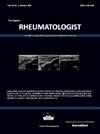Cognitive impairment in radiographic axial spondyloarthritis patients and its relation to disease characteristics
IF 1
Q4 RHEUMATOLOGY
引用次数: 0
Abstract
Aim of the work
Cognitive involvement in patients with radiographic axial spondyloarthritis (r-axSpA) has not been sufficiently studied. This study aimed to assess cognitive functions in these patients and their relation to disease characteristics.
Patients and methods
Sixty r-axSpA patients and 60 age, sex- and education-matched healthy controls were enrolled. Disease activity was assessed by the Bath Ankylosing Spondylitis Disease Activity Index (BASDAI) and functional impairment by the Bath Ankylosing Spondylitis Functional Index (BASFI). Patients and controls were assessed by the Depression, Anxiety and Stress scale (DASS) and the Montreal Cognitive Assessment (MoCA) Basic test.
Results
The mean age of the patients was 35.8 ± 8.6 years, median disease duration of 10 years, 52 (86.7 %) were males and the educational attainment was 13.4 ± 4.7 years. The median BASDAI was 4.45 (3.75– 5.65) and BASFI was 5.1 (3.5–6.7). The patients experienced different grades of depression (78.4 %), anxiety (71.7 %) and stress (76.7 %) compared to 15 %, 31.7 %, and 30 % of the control, respectively (p < 0.001). Eighteen (30 %) patients showed impaired cognitive functions on the MoCA B test (score < 26) versus none of the controls (p < 0.001). Executive function, immediate recall, fluency, abstraction and visuoperception were more frequently involved in patients (p = 0.001, p = 0.022, p = 0.011, p = 0.001 and p = 0.001, respectively). Impaired MoCA was significantly associated with older age (p = 0.029), lower education levels (p = 0.003), and higher BASFI (p = 0.003), but not with disease duration, BASDAI or DASS scores.
Conclusion
Cognitive impairment is frequent among r-axSpA patients and is associated with older age, lower educational attainment, and more functional limitations.
影像学诊断中轴性脊柱炎患者的认知障碍及其与疾病特征的关系
研究目的:影像学诊断的中轴性脊柱炎(r-axSpA)患者的认知介入尚未得到充分的研究。本研究旨在评估这些患者的认知功能及其与疾病特征的关系。患者和方法纳入60例r-axSpA患者和60例年龄、性别和教育程度相匹配的健康对照。疾病活动性采用Bath强直性脊柱炎疾病活动性指数(BASDAI)评估,功能损害采用Bath强直性脊柱炎功能指数(BASFI)评估。采用抑郁、焦虑和压力量表(DASS)和蒙特利尔认知评估(MoCA)基本测试对患者和对照组进行评估。结果患者平均年龄35.8±8.6岁,中位病程10年,男性52例(86.7%),文化程度13.4±4.7岁。中位BASDAI为4.45 (3.75 - 5.65),BASFI为5.1(3.5-6.7)。患者有不同程度的抑郁(78.4%)、焦虑(71.7%)和压力(76.7%),而对照组分别为15%、31.7%和30% (p <;0.001)。18例(30%)患者在MoCA B测试中显示认知功能受损(评分<;26)而没有任何对照(p <;0.001)。执行功能、即时回忆、流畅性、抽象性和视觉感觉在患者中更常见(p = 0.001, p = 0.022, p = 0.011, p = 0.001和p = 0.001)。MoCA受损与年龄较大(p = 0.029)、受教育程度较低(p = 0.003)和BASFI升高(p = 0.003)显著相关,但与病程、BASDAI或DASS评分无关。结论r-axSpA患者认知功能障碍较为常见,且与年龄较大、受教育程度较低、功能限制较多有关。
本文章由计算机程序翻译,如有差异,请以英文原文为准。
求助全文
约1分钟内获得全文
求助全文

 求助内容:
求助内容: 应助结果提醒方式:
应助结果提醒方式:


